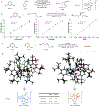Catalytic asymmetric addition of an amine N-H bond across internal alkenes
- PMID: 33142305
- PMCID: PMC8638802
- DOI: 10.1038/s41586-020-2919-z
Catalytic asymmetric addition of an amine N-H bond across internal alkenes
Abstract
Hydroamination of alkenes, the addition of the N-H bond of an amine across an alkene, is a fundamental, yet challenging, organic transformation that creates an alkylamine from two abundant chemical feedstocks, alkenes and amines, with full atom economy1-3. The reaction is particularly important because amines, especially chiral amines, are prevalent substructures in a wide range of natural products and drugs. Although extensive efforts have been dedicated to developing catalysts for hydroamination, the vast majority of alkenes that undergo intermolecular hydroamination have been limited to conjugated, strained, or terminal alkenes2-4; only a few examples occur by the direct addition of the N-H bond of amines across unactivated internal alkenes5-7, including photocatalytic hydroamination8,9, and no asymmetric intermolecular additions to such alkenes are known. In fact, current examples of direct, enantioselective intermolecular hydroamination of any type of unactivated alkene lacking a directing group occur with only moderate enantioselectivity10-13. Here we report a cationic iridium system that catalyses intermolecular hydroamination of a range of unactivated, internal alkenes, including those in both acyclic and cyclic alkenes, to afford chiral amines with high enantioselectivity. The catalyst contains a phosphine ligand bearing trimethylsilyl-substituted aryl groups and a triflimide counteranion, and the reaction design includes 2-amino-6-methylpyridine as the amine to enhance the rates of multiple steps within the catalytic cycle while serving as an ammonia surrogate. These design principles point the way to the addition of N-H bonds of other reagents, as well as O-H and C-H bonds, across unactivated internal alkenes to streamline the synthesis of functional molecules from basic feedstocks.
Conflict of interest statement
Competing Interests
The authors declare no competing interests.
Figures




References
-
- Müller TE & Beller M. Metal-Initiated Amination of Alkenes and Alkynes. Chem. Rev 98, 675–704 (1998). - PubMed
-
- Müller TE, Hultzsch KC, Yus M, Foubelo F. & Tada M. Hydroamination: Direct Addition of Amines to Alkenes and Alkynes. Chem. Rev 108, 3795–3892 (2008). - PubMed
-
- Huang L, Arndt M, Gooßen K, Heydt H. & Gooßen LJ Late Transition Metal-Catalyzed Hydroamination and Hydroamidation. Chem. Rev 115, 2596–2697 (2015). - PubMed
-
- Reznichenko AL & Hultzsch KC in Hydroamination of Alkenes. In Organic Reactions 1–554 (2015).
-
- Gurak JA, Yang KS, Liu Z. & Engle KM Directed, Regiocontrolled Hydroamination of Unactivated Alkenes via Protodepalladation. J. Am. Chem. Soc 138, 5805–5808 (2016). - PubMed

